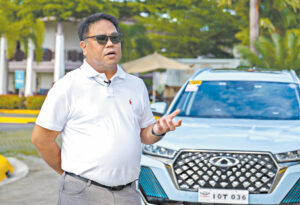Interview by Kap Maceda Aguila
THE UNITED ASIA AUTOMOTIVE GROUP, INC. (UAAGI) has been plenty busy of late, particularly with the addition of two auto brands — BAIC and Lynk and Co — joining Foton and Chery in its fold. Recently, UAAGI officials staged the “Choose Your Own Adventure” media drive from Manila to Subic featuring 14 models across its four marques. “This is the first time that we’ve done this for all our UAAGI brands… an opportunity for the media to test-drive the cars that we have in the group’s portfolio,” said UAAGI Group Managing Director Froilan Dytianquin in an interview with “Velocity.”
As well as growing its offerings, UAAGI is also reaching out to more segments of car buyers. This is certainly good news for the distributor’s established dealer partners. “We’re giving our dealers of Foton and Chery dibs on our new brands Lynk and Co, and BAIC, so they can also expand their offerings in the areas they’re already covering — and complete their overall portfolios,” he added.
Here are excerpts from our exclusive interview.
VELOCITY: UAAGI has really grown its portfolio. Can you give us a rundown of the brands and their target markets?
FROILAN DYTIANQUIN: The four brands that we now have under the UAAGI portfolio actually do not compete with each other. Foton, the original brand that we have had for a while now, caters to the commercial vehicle market — from pickups to large trucks, buses, and heavy equipment. Chery, on the other hand, has been our mainstream brand focusing on crossovers. I would say the growth in crossover sales here is quite significant, as people now try to move from sedans to these.
Then Lynk and Co, and BAIC are two distinct brands as well. For Lynk and Co, the models that we have — crossovers and SUVs — are actually positioned as mid-premium. The direction for the brand is toward beautiful, energetic vehicles catering to the younger generation. Later on, you will also recognize that we’re moving the models to more sustainable platforms. Right now, we have the plug-in hybrid electric vehicle, 01, and we will further expand the models to include other PHEVs. BAIC is more for four-wheel-drive enthusiasts and those who are into large SUVs. This is how we position the brand. Of course, BAIC was in the country previously in the early 2000s, but the brand was focusing on crossovers then; again right now, they are now more into large sport utility vehicles for four-wheel-drive users. That has been the focus.
Significantly, all the brands that UAAGI carries are made or are headquartered in China. Foton has been here for a while now. How do you see the market perception for Chinese brands in general — particularly since there are so many of them here now? Are you seeing a shift in the way that people browse for vehicles? Before, it used to be just the Americans, Japanese, and the Korean brands.
When we look at the history of Japanese or Korean auto brands, they all started the same. They started slow; people did not accept them right away. But as they improved on quality and technology, buyers started to rely on them. This is something that we need to understand. Right now, there’s geopolitical tension which extends to Chinese brands. Having said that, Chinese brands right now have the edge with regard to technology. Everything’s already at the forefront. Chinese brands are heading EV technology.
In terms of research and development, most of the Chinese brands have already partnered with their European counterparts. So, I guess it’s a matter of time — again similar to what happened for Japanese and Korean brands — for people to discover that Chinese marques have really evolved into something that I would consider first class in terms of quality, reliability and, of course, technology.
It’s good that you mentioned geopolitical tensions but, in general, do you think that the public’s mindset has changed with regard to how it views made-in-China products?
I think the millennials, the younger people, already accept them or at least are willing to look beyond the traditional Japanese, Korean, American brands. We can see this in cell phones. Young people don’t stick to the leading brands, and they try to explore the other options, especially Chinese. These cell phones are already becoming more advanced… I came from another Chinese auto brand, and I remember we used the term “reverse mentoring,” which means that it’s now the young who are mentoring, let’s say, their parents or their uncles, on these new brands.
